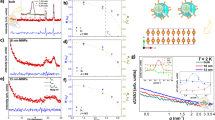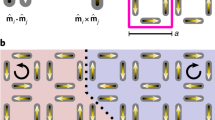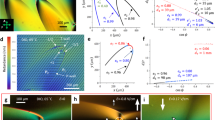Abstract
More than four decades ago, Brochard and de Gennes proposed that colloidal suspensions of ferromagnetic particles in nematic (directionally ordered) liquid crystals could form macroscopic ferromagnetic phases at room temperature. The experimental realization of these predicted phases has hitherto proved elusive, with such systems showing enhanced paramagnetism but no spontaneous magnetization in the absence of an external magnetic field. Here we show that nanometre-sized ferromagnetic platelets suspended in a nematic liquid crystal can order ferromagnetically on quenching from the isotropic phase. Cooling in the absence of a magnetic field produces a polydomain sample exhibiting the two opposing states of magnetization, oriented parallel to the direction of nematic ordering. Cooling in the presence of a magnetic field yields a monodomain sample; magnetization can be switched by domain wall movement on reversal of the applied magnetic field. The ferromagnetic properties of this dipolar fluid are due to the interplay of the nematic elastic interaction (which depends critically on the shape of the particles) and the magnetic dipolar interaction. This ferromagnetic phase responds to very small magnetic fields and may find use in magneto-optic devices.
This is a preview of subscription content, access via your institution
Access options
Subscribe to this journal
Receive 51 print issues and online access
$199.00 per year
only $3.90 per issue
Buy this article
- Purchase on Springer Link
- Instant access to full article PDF
Prices may be subject to local taxes which are calculated during checkout





Similar content being viewed by others
References
Poulin, P., Stark, H., Lubensky, T. C. & Weitz, D. A. Novel colloidal interactions in anisotropic fluids. Science 275, 1770–1773 (1997)
Muševič, I., Škarabot, M., Tkalec, U., Ravnik, M. & Žumer, S. Two-dimensional nematic colloidal crystals self-assembled by topological defects. Science 313, 954–958 (2006)
Lapointe, C. P., Mason, T. G. & Smalyukh, I. I. Shape-controlled colloidal interactions in nematic liquid crystals. Science 326, 1083–1086 (2009)
Lavrentovich, O. D. Liquid crystals, photonic crystals, metamaterials, and transformation optics. Proc. Natl Acad. Sci. USA 108, 5143–5144 (2011)
Paulson, D. N. & Wheatley, J. C. Evidence for electronic ferromagnetism in superfluid 3He-A. Phys. Rev. Lett. 40, 557–561 (1978)
Albrecht, T. et al. First observation of ferromagnetism and ferromagnetic domains in a liquid metal. Appl. Phys. A 65, 215–220 (1997)
Brochard, F. & de Gennes, P. G. Theory of magnetic suspensions in liquid crystals. J. Phys. 31, 691–708 (1970)
Born, M. Über anisotrope Flüssigkeiten. Versuch einer Theorie der flüssigen Kristalle und des elektrischen Kerr-Effekts in Flüssigkeiten. Sitz. Kön. Preuss. Akad. Wiss. 30, 614–650 (1916)
Ilg, P. & Odenbach, S. in Colloidal Magnetic Fluids: Basics, Development and Application of Ferrofluids (ed. Odenbach, S. ) 249–326 (Springer, 2009)
Rosensweig, R. E. Ferrohydrodynamics 237–269 (Dover, 1997)
Senyuk, B. et al. Shape-dependent oriented trapping and scaffolding of plasmonic nanoparticles by topological defects for self-assembly of colloidal dimers in liquid crystals. Nano Lett. 12, 955–963 (2012)
Senyuk, B. & Smalyukh, I. I. Elastic interactions between colloidal microspheres and elongated convex and concave nanoprisms in nematic liquid crystals. Soft Matter 8, 8729–8734 (2012)
Eskandari, Z., Silvestre, N. M., Tasinkevych, M. & da Gama, M. M. T. Interactions of distinct quadrupolar nematic colloids. Soft Matter 8, 10100–10106 (2012)
Rault, J., Cladis, P. E. & Burger, J. P. Ferronematics. Phys. Lett. A 32, 199–200 (1970)
Chen, S.-H. & Amer, N. M. Observation of macroscopic collective behavior and new texture in magnetically doped liquid crystals. Phys. Rev. Lett. 51, 2298–2301 (1983)
Kopčanský, P. et al. Structural changes in the 6CHBT liquid crystal doped with spherical, rodlike, and chainlike magnetic particles. Phys. Rev. E 78, 011702 (2008)
Buluy, O. et al. Magnetic sensitivity of a dispersion of aggregated ferromagnetic carbon nanotubes in liquid crystals. Soft Matter 7, 644–649 (2011)
Podoliak, N. et al. Macroscopic optical effects in low concentration ferronematics. Soft Matter 7, 4742–4749 (2011)
Podoliak, N. et al. Magnetite nanorod thermotropic liquid crystal colloids: synthesis, optics and theory. J. Colloid Interf. Sci. 386, 158–166 (2012)
Lev, B. I., Chernyshuk, S. B., Tomchuk, P. M. & Yokoyama, H. Symmetry breaking and interaction of colloidal particles in nematic liquid crystals. Phys. Rev. E 65, 021709 (2002)
Ovtar, S., Lisjak, D. & Drofenik, M. Barium hexaferrite suspensions for electrophoretic deposition. J. Colloid Interface Sci. 337, 456–463 (2009)
Lisjak, D. & Drofenik, M. Chemical substitution—an alternative strategy for controlling the particle size of barium ferrite. Cryst. Growth Des. 12, 5174–5179 (2012)
Moreno-Razo, J. A. et al. Effects of anchoring strength on the diffusivity of nanoparticles in model liquid-crystalline fluids. Soft Matter 7, 6828–6835 (2011)
Evans, J. S., Beier, C. N. & Smalyukh, I. I. Alignment of high-aspect ratio colloidal gold nanoplatelets in nematic liquid crystals. J. Appl. Phys. 110, 033535 (2011)
Mahle, S., Ilg, P. & Liu, M. Hydrodynamic theory of polydisperse chain-forming ferrofluids. Phys. Rev. E 77, 016305 (2008)
López-López, M. T., Zubarev, A. Y. & Bossis, G. Repulsive force between two attractive dipoles, mediated by nanoparticles inside a ferrofluid. Soft Matter 6, 4346–4349 (2010)
Dalton, L. R., Harper, A. W. & Robinson, B. H. The role of London forces in defining noncentrosymmetric order of high dipole moment–high hyperpolarizability chromophores in electrically poled polymeric thin films. Proc. Natl Acad. Sci. USA 94, 4842–4847 (1997)
de Gennes, P. G. & Prost, J. The Physics of Liquid Crystals 41–162 (Clarendon, 1995)
Pleiner, H., Jarkova, E., Muler, H. W. & Brand, H. R. Landau description of ferrofluid to ferronematic phase transition. Magnetohydrodynamics 37, 254–260 (2001)
Jarkova, E., Pleiner, H., Müller, H.-W. & Brand, H. R. Macroscopic dynamics of ferronematics. J. Chem. Phys. 118, 2422–2430 (2003)
Liechtenstein, A. I., Katsnelson, M. I. & Gubanov, V. A. Exchange interactions and spin-wave stiffness in ferromagnetic metals. J. Phys. F 14, L125–L128 (1984)
Acknowledgements
This work was supported by the Slovenian Research Agency (A.M. and M.Č., grant no. P1-0192; D.L. and M.D., grant no. P2-0089-4). We thank the CENN Nanocenter for use of the LakeShore 7400 Series vibrating-sample magnetometer.
Author information
Authors and Affiliations
Contributions
A.M. designed the study and performed the experiments; A.M. and M.Č. interpreted results and wrote the paper; and D.L. and M.D. designed and synthesized nanoplatelets, and prepared the suspension of nanoplatelets in isotropic solvent.
Corresponding author
Ethics declarations
Competing interests
The authors declare no competing financial interests.
Extended data figures and tables
Extended Data Figure 1 Images of polydomain samples with different concentrations of magnetic nanoplatelets in an external magnetic field.
The director lies in the plane of the sample either parallel or perpendicular to the external magnetic field, B. P and A show directions of polarizer and analyser, respectively. The scale bar in the first image is 40 µm.
Extended Data Figure 2 Images of monodomain samples with different concentrations of magnetic nanoplatelets in an external magnetic field.
The director lies in the plane of the sample either parallel or perpendicular to the external magnetic field. The scale bar in the first image is 40 µm.
Extended Data Figure 3 Sequence of images showing domain growth.
The external magnetic field is slowly increased in a sample that was quenched in the absence of an external magnetic field. The direction of the external field is perpendicular to n. If the field is switched off, the initial dark field is obtained. However, if the field is switched on immediately or within a few hours, the formed domains are still visible. The concentration of the platelets in 5CB was 0.16 wt%. The scale bar in the first image is 40 µm.
Extended Data Figure 4 Sequence of images showing transition from a polydomain to a monodomain sample.
The external field is parallel to n. The white lines are the edges of domain walls. The concentration of the platelets in 5CB was 0.3 wt%. The scale bar in the first image is 40 µm.
Extended Data Figure 5 Sequence of images showing the complete switching of a monodomain sample.
The field is applied parallel to n and in reverse direction to the field that was used during the quench to nematic phase and then switched off. Travelling white lines are the surface domain walls, where the director rotates by π. The concentration of the platelets in 5CB was 0.16 wt%. The scale bar in the first image is 40 µm.
Rights and permissions
About this article
Cite this article
Mertelj, A., Lisjak, D., Drofenik, M. et al. Ferromagnetism in suspensions of magnetic platelets in liquid crystal. Nature 504, 237–241 (2013). https://doi.org/10.1038/nature12863
Received:
Accepted:
Published:
Issue Date:
DOI: https://doi.org/10.1038/nature12863
This article is cited by
-
Saturation magnetisation as an indicator of the disintegration of barium hexaferrite nanoplatelets during the surface functionalisation
Scientific Reports (2023)
-
Two-Dimensional Ferronematics, Canonical Harmonic Maps and Minimal Connections
Archive for Rational Mechanics and Analysis (2023)
-
Dynamic magnetic field alignment and polarized emission of semiconductor nanoplatelets in a liquid crystal polymer
Nature Communications (2022)
-
Tunable order in colloids of hard magnetic hexaferrite nanoplatelets
Nano Research (2022)
-
A Two-Fluid Model for the Macroscopic Behavior of Nematic Fluids and Gels in a Chiral Solvent
Brazilian Journal of Physics (2022)
Comments
By submitting a comment you agree to abide by our Terms and Community Guidelines. If you find something abusive or that does not comply with our terms or guidelines please flag it as inappropriate.



